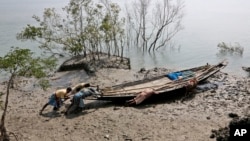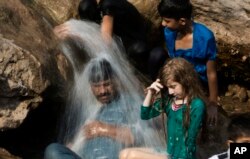A scientist at the Massachusetts Institute of Technology says people will not be able to live in parts of South Asia by the year 2100 if little is done to stop climate change.
Elfatih Eltahir studies the world’s climate. He was among the writers of a recently published report in the journal Science Advances.
He said, “the heat wave intensity will reach magnitudes that have not been observed before.”
Eltahir’s study takes humidity into consideration, along with heat.
The researchers believe the combination of the heat and humidity will make areas in South Asia difficult to live in.
The researchers used a measurement called “wet bulb temperature.” It is based on air temperature and the amount of water in the air.
A very high wet bulb temperature prevents humans from being able to cool themselves by sweating.
The researchers say that if the wet bulb temperature reaches 35 degrees Celsius, it would feel like an air temperature of 72 degrees Celsius. That would make it difficult for humans to cool down, even in the shade.
Parts of the world where there is poverty, large populations, and heat and humidity would be in danger. That includes places in South Asia, such as: the Ganges River valley, northeastern India, and Bangladesh. Other areas that might be affected are the eastern coast of India, the Chota Nagpur Plateau, northern Sri Lanka, and the Indus valley of Pakistan.
The researchers said people in those areas would be in danger within about 50 years if unlimited heat-trapping gasses continue to be put into the atmosphere.
Alexis Berg is a hydro-climatologist at Princeton University. He was not involved in the study. He said that the temperatures in South Asia would not remain high permanently. But even a short heat wave could be deadly.
The researchers also noted the possibility that heat trapping gasses will not be reduced at all but continue to be released into the atmosphere.
Scientists call this worst-case scenario RCP 8.5. The study’s writers said that if RCP 8.5 takes place, about 30 percent of the world’s population would regularly be exposed to dangerous temperatures.
Matthew Huber is a climate scientist at Purdue University in the state of Indiana. He was not involved with the study. However, he called RCP 8.5 “a death sentence for a large fraction of the world.”
But he also said that kind of climate change can be avoided.
“The choice is very much ours,” he said. “It does not require impossible effort to avoid RCP 8.5.”
Huber said the study was more complete than earlier reports about heat.
Berg, the Princeton scientist, said there is still time to prevent the worst case scenario. He also said, however, that without change, the heat will continue to get more dangerous.
I’m Dan Friedell.
Ben Thompson wrote this story for VOANews.com. Dan Friedell adapted it for Learning English. Mario Ritter was the editor.
Do you think we will be able to slow down global warming? We want to know. Write to us in the Comments Section or on our Facebook page.
______________________________________________________________
Words in This Story
magnitude – n. the size, extent, or importance of something
humidity – n. the amount of moisture in the air
sweat – v. to produce a clear liquid from your skin when you are hot or nervous
shade – n. an area of slight darkness that is produced when something blocks the light of the sun
worst-case scenario – n. the worst description of what could possible happen
fraction – n. a part or amount of something









